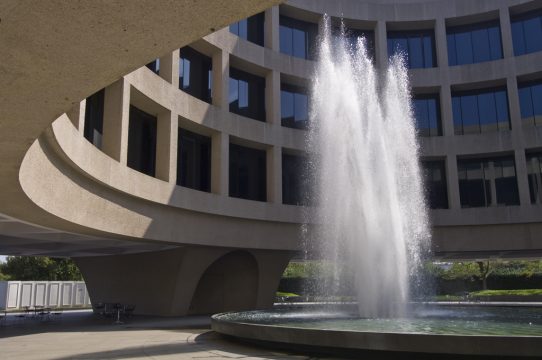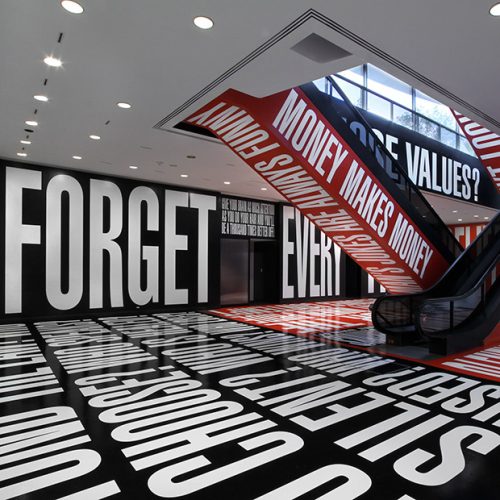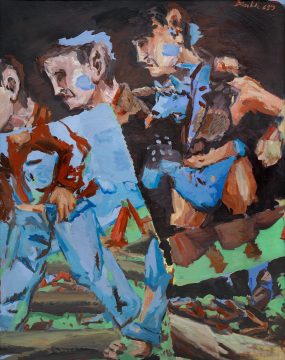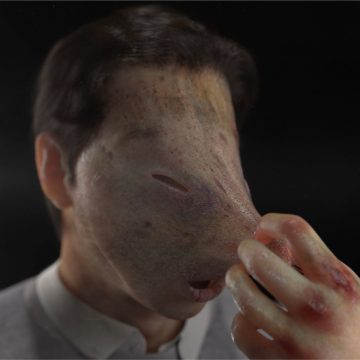Advance Exhibition Schedule Fall/Winter 2017

Upcoming

SEPTEMBER 1–OCTOBER 14, 2018
Curated by Mark Beasley – Plaza and Sculpture Garden
“This You”—the first exclusively live work acquired for the Museum’s permanent collection in its forty-four-year history—will feature a solo female singer who will connect with visitors to produce intimate and memorable experiences.Created in part as a response to the over-proliferation of objects, these intimate encounters will leave behind only personal memories. Expanding on the work of Conceptual artists, Tino Sehgal employs the body, voice, and movement to create his works rather than traditional art materials. Referred to as “constructed situations” by the artist, they will not be documented through recordings, photographs, or videos but remain ephemeral.
For its presentation at the Hirshhorn, “This You” will feature Tattiana Aqeel, Erin Frisby, Arielle Goodman, Briona Jackson, Sadie Leigh, Christiana Lyra, Jahnel Daliya, and Lara Supan. An interpreter will be present and performing any time the Museum is open during the work’s entire run.

SEPTEMBER 13, 2018–FEBRUARY 3, 2019
Curated by Stéphane Aquin
A major highlight of the 56th Venice Biennale, Sean Scully’s acclaimed Landline series makes its U.S. debut at the Hirshhorn. Featuring never-before-seen artworks from the renowned series, Sean Scully: Landline presents a dramatic shift in the work of one of today’s most influential artists. With thick, gestural brushstrokes and loose bands of color, the Landline paintings show Scully’s transition away from his earlier hard-edged minimalism to his current, more expressive style, a style that no doubt elicits the beauty and brilliance of the natural world.
Spanning a variety of media—including watercolor, oil painting, and sculpture—the works in the exhibition showcase the artist’s remarkable ability to deepen, mystify, and vary his relatively limited repertoire of motifs—largely comprised of vertical and horizontal stripes. With gestures toward the land, sea, and sky (and the indistinct lines between them), the works navigate the elemental relationships that compose our world, and in doing so reveal the sublime character of those interactions. Together, the works will transform the Hirshhorn’s Second Level inner-circle galleries into an unceasing current of color and energy.
This exhibition debuts more than twenty years after the Hirshhorn opened Scully’s first mid-career retrospective in 1995, a pivotal exhibition that cemented his status at the center of contemporary painting. Building on the narrative of this 1995 survey, Sean Scully: Landline affords viewers the opportunity to witness the next step in Scully’s artistic evolution, one that continues to impact the greater landscape of contemporary abstract art. Following its Hirshhorn debut, the series will travel to the Wadsworth Atheneum Museum of Art in Hartford, Connecticut, in Spring 2019.
NOV 1, 2018–APR 28, 2019
Curated by Stéphane Aquin
Organized by the Fondation Beyeler – Second Level
Three major interactive installations from Mexican Canadian artist Rafael Lozano-Hemmer’s Pulse series and six public-art documentaries come together for the first time in Rafael Lozano-Hemmer: Pulse, which will fill the museum’s galleries with evocative, immersive environments that use heart-rate sensors to create kinetic and audiovisual experiences from visitors’ own biometric data. Rafael Lozano-Hemmer: Pulse will animate the vital signs of hundreds of thousands of participants in the Hirshhorn’s largest interactive technology exhibition to date.
With Lozano-Hemmer’s trademark sensitivities to audience engagement and architectural scale, each artwork detects the biometric signatures of each visitor, registering and recording them as repetitive sequences that are visualized as flashing lights, panning soundscapes, waves in ripple tanks and animated fingerprints. These “portraits” or “snapshots” of the visitor’s intimate electrical activity then gets added to a live archive of other recordings, creating a landscape of syncopated rhythms. At a time when biometry is increasingly used for identification and control, here agglomerated data presents a new form of anonymity.
The exhibition begins with Pulse Index (2010), which records participants’ fingerprints at the same time as it detects their heart rates, displaying data for the last 10,000 users on a Fibonacci-sequenced grid of massive projections. The second work visitors will encounter is Pulse Tank, featuring illuminated water tanks that show participants’ pulses through ripples on the water’s surface, reflected in shadow patterns on the gallery walls. The last installation, Pulse Room (2006), is an otherworldly space filled with hundreds of clear, incandescent light bulbs hanging from the ceiling in even rows, pulsing with the heartbeats of past visitors. Visitors add their heartbeat by touching a sensor near the beginning of the installation, transmitting their pulse to the first bulb, which then flickers to its rhythm.
Six short documentaries of Pulse works will also be exhibited, showing biometric public-art interventions in Abu Dhabi, Toronto, Hobart, New York and Urdaibai, Spain (2007–2015).

NOV 8, 2018–JAN 27, 2019
Curated by Evelyn C. Hankins
The largest US museum survey of this pioneering artist to date, Charline von Heyl: Snake Eyesfeatures more than thirty large-scale paintings that reveal the artist’s considerable influence in the field of contemporary art.
One of the most inventive artists working today, von Heyl has earned international acclaim for continually rethinking the possibilities of contemporary painting. Her cerebral yet deeply visceral artworks upend longstanding assumptions about composition, beauty, and narrative. Drawing inspiration from a vast and surprising array of sources—including literature, pop culture, metaphysics, and personal history—von Heyl creates paintings that are seemingly familiar yet impossible to classify, offering, in her words, “a new image that stands for itself as fact.”
Organized in collaboration with the Deichtorhallen Hamburg, this major multinational exhibition highlights the artist’s groundbreaking artistic output since 2005, including recent works that point to new developments in her constantly evolving practice. Together, Snake Eyes shines an international spotlight on one of today’s most dynamic painters and demonstrates the vitality and limitless possibilities of painting.
ENRICO DAVID: GRADATIONS OF SLOW RELEASE

APR 18–SEP 2, 2019
Curated by Michael Darling for the Museum of Contemporary Art Chicago
Curated by Stéphane Aquin for the Hirshhorn
Organized by Museum of Contemporary Art Chicago
Featuring twenty years of artistic output, Enrico David: Gradations of Slow Release is the largest US museum survey of the artist’s works to date. Co-organized with the Museum of Contemporary Art Chicago, and curated by Michael Darling, the James W. Alsdorf Chief Curator, MCA Chicago, this exhibition shows the breadth and versatility of a distinguished artist, one whose practice is characterized by transformation.
Enrico David (Italian, b. Ancona, 1966) is one of the most original artists working today. Based in London, David employs a variety of media—including sculpture, painting, installation, and works on paper—to develop a dynamic and unique vision of the human form and the ever-shifting sense of being that rests therein. Often fragile, vulnerable, grotesque, and mutable, David’s imagery achieves a universal expression of the human experience, albeit through a deeply personal formulation.
The subtitle of the exhibition, Gradations of Slow Release, is taken from a sculpture of the same name. The work, much like the show, represents the way imagery, ideas, and characterizations of being can morph and evolve over time, slowly through the maelstrom of change. Situated within the curved gallery spaces of the Hirshhorn’s Second Level inner-circle, David’s works reveal the many themes coursing through his expansive practice, including notions of interiority, multiplicity, and disembodiment. More than that, they reflect the circular process inherent to his craft, where the human form is shaped and reshaped and continuously made anew.
On View
THROUGH SEP 16, 2018
Curated by Stéphane Aquin
Organized in partnership with Fondation Beyeler – Second Level
Baselitz: Six Decades is the first major U.S. retrospective in more than twenty years of one of Germany’s greatest living artists, marking the artist’s eightieth birthday. With more than one hundred works highlighting every phase of Baselitz’s six-decade career from the 1950s to today, this milestone exhibition features work never before seen in the U.S. and cements Baselitz’s reputation as one of the most original and inventive figurative artists of his generation.
For the first time, U.S. audiences can experience the full scope of Baselitz’s powerful explorations of the human figure, as well as the influence of American artists on his early work and his continued impact on contemporary American painting and sculpture. Baselitz’s creative genius, combined with his message about the inherent strength of the everyday human condition, make this exhibition particularly compelling.
Organized chronologically, Baselitz: Six Decades will feature iconic paintings, works on paper and wood and bronze sculptures. The show will include one of Baselitz’s most notable works of that period, The Naked Man (1962), in which the artist used a shocking image of a male figure to express the pervasive discontent with Germany’s socialist politics. Additional highlights will be the celebrated paintings from his iconic Helden (Heroes) and Fracture series (1965–1966), which underscore the strength of the German people following World War II.
Organized in partnership with the Fondation Beyeler, the exhibition is curated by Hirshhorn chief curator Stéphane Aquin and the Beyeler curator-at-large Martin Schwander. It opened at the Beyeler in Basel, Switzerland on January 21, before traveling to D.C. The Hirshhorn hosted Baselitz’s first-ever career retrospective in 1996, and this new exhibition builds on that milestone with an expanded look at his exceptional career.
THROUGH SEPTEMBER 23, 2018
Curated by Mark Beasley
Organized by the Hirshhorn – Lower Level
Drawing primarily from the Hirshhorn’s recent film and video acquisitions, The Message features works that rewire popular modes of address—namely the public lecture, the concert, the music video, and the online sex chat room. Language is at the root of each work from the redeployment of pop verse and the operatic libretto to the repurposing of the pedagogic lecture and online messaging. Through the juxtaposition and collage of existing classical and pop forms, each of the assembled artists seeks to rethink dominant narratives and ideologies and assess the impact of history on the present moment.
In Grosse Fatigue (2013), Camille Henrot searches the Smithsonian archives for creation tales that she weaves into an endless wash of anthropological, philosophical, and literary beginnings. Hito Von Steyerl’s film essay-cum-performance lecture How Not to be Seen (2013) explains how one can remain invisible and avoid detection in an age of constant surveillance. C.T. Jasper and Joanna Malinowska’s Halka/Haiti (2015) delivers opera to the tropics through their public staging of a Polish love story in a Haitian village populated by citizens of Polish descent. Kanye West provides the soundtrack for Arthur Jafa’s Love is the Message, The Message is Death (2016), a filmic essay of triumph, tragedy, and resilience. Lastly, in France Stark’s My Best Thing (2011) an encounter with a young man in a sex chat room leads to an unlikely basis for creative collaboration in the face of performance anxiety.
MARK BRADFORD: PICKETT’S CHARGE
THROUGH NOV 12, 2018
Curated by Evelyn Hankins and Stéphane Aquin
Organized by the Hirshhorn – Third Level Inner Ring
Internationally renowned artist Mark Bradford will debut Pickett’s Charge, a monumental new, site-specific commission inspired by the immersive form of the cyclorama as well as the Museum’s distinctive architecture. The installation, which comprises a series of eight powerful, abstract paintings, each more than forty-five feet long, will encircle the entire Third Level, creating an immersive, 360-degree experience. Drawing directly from artist Paul Philippoteaux’s landmark nineteenth-century cyclorama depicting the final charge of the Battle of Gettysburg, Pickett’s Charge invites visitors to interrogate conventional historical narratives. Weaving together reproductions of the original 1883 painting with multiple layers of colored paper, Bradford transforms the historic imagery to reveal the hidden textures and complexities lurking just beneath the surface.
Bradford (b. 1961) lives and works in Los Angeles. Bradford has achieved wide acclaim for a technically inventive and uniquely powerful abstraction that is steeped in a personal exploration of history and the sociopolitical issues shaping the world. Pickett’s Charge will be Bradford’s first solo exhibition in Washington, DC, and his first major American solo show following his presentation as the U.S. representative for the 57th Venice Biennale.
THROUGH SPRING 2020
Curated by Gianni Jetzer
Organized by the Hirshhorn – Third Level
What Absence Is Made Of presents artworks from the last 65 years that investigate the space between the tangible and the intangible. Selected from the Hirshhorn’s permanent collection, the exhibition highlights new acquisitions by Annette Lemieux, Ed Atkins, and Huang Yong Ping, as well as collection favorites by Ana Mendieta, John Baldessari, Fred Sandback, and Ann Hamilton. The artists featured utilize absence as a powerful component in their work, employing such methods as reduction, erasure, negative space, and monochrome. Focusing on prominent themes in art since the 1960s, the exhibition charts the rising appeal of immateriality in reaction to an increasingly material world.
BARBARA KRUGER: BELIEF AND DOUBT

ONGOING
Curated by Melissa Ho
Organized by the Hirshhorn – Lower Level
Part of an initiative to bring art to new sites within and around the building, this installation by Barbara Kruger fills the Lower Level lobby and extends into the newly relocated Museum bookstore. Famous for her incisive photomontages, Kruger has focused increasingly over the past two decades on creating environments that surround the viewer with language. The entire space—walls, floor, escalator sides—is wrapped in text-printed vinyl, immersing visitors in a spectacular hall of voices, where words either crafted by the artist or borrowed from the popular lexicon address conflicting perceptions of democracy, power, and belief.
At a moment when ideological certitude and purity seem especially valued, Kruger says she’s “interested in introducing doubt.” Large areas of the installation are devoted to open-ended questions, while the section occupying the bookstore explores themes of desire and consumption. At once addressing the individual, the museum, and, symbolically, the country, Kruger’s penetrating examination of the public sphere transforms one of the Hirshhorn’s key public spaces.




